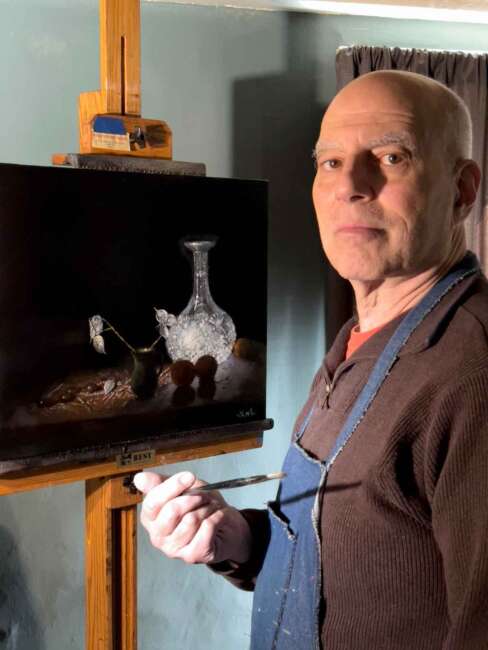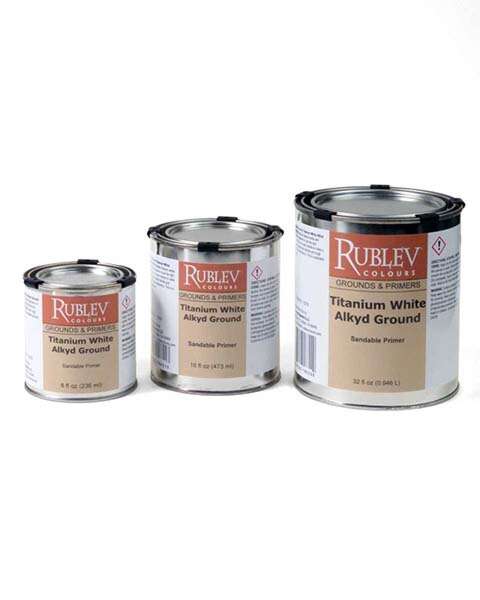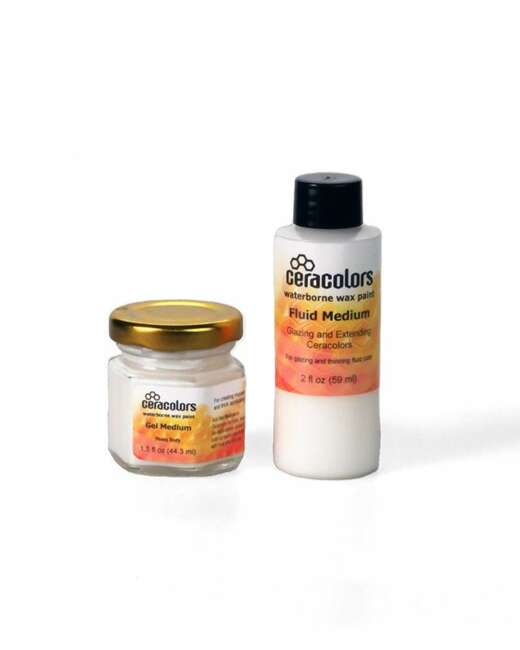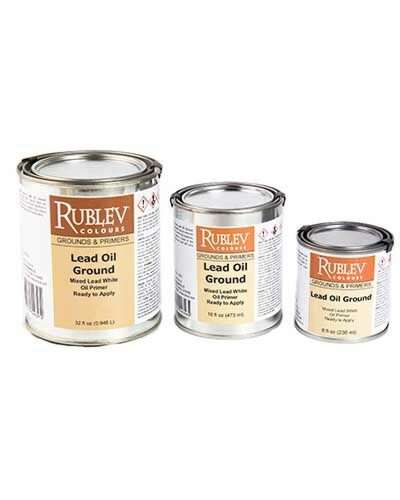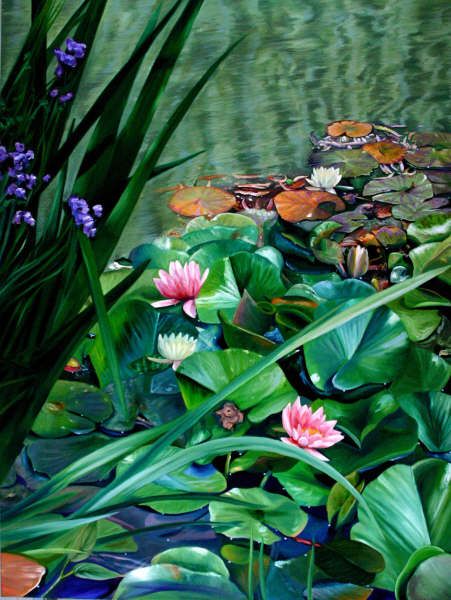
By Kenneth Freed
To painters, discussing mediums can be like a political debate. There are pro-Maroger, anti-Maroger, pro-natural resins, and anti-natural resins, as well as pro-alkyd and anti-alkyd proponents. The disputes are always about potential cracking, lack of adhesion, and yellowing. I have always been curious and experimented with almost every medium I could get my hands on. However, if you are new to painting, the best approach is to experiment with the paint right out of the tube so that you can understand and fully integrate into your procedure what the paint can do without additives.
I have tried to list some of my thoughts concerning the subject in this article. Much is left out and much is ignored, but I thought there might be something here to encourage a discussion. I have spent considerable time during my 40-year career, experimenting and attempting to understand how different mediums work and why a painter would choose to use them in the first place. All of the statements that I make in this article are opinions or conclusions drawn from years of trials, experimentation, and, in some cases, constant use. Some of the statements are very general because whether the mediums work for you like they do for me are related to environmental issues (i.e., substrate, ground, etc.).
Salvador Dali, in his book 50 Secrets of Magic Craftsmanship, indicated that oil painting is about controlling the viscosity of paint. It has taken many years before I fully realized the impact of what he was saying. Mediums can be used for different purposes. Artists use mediums in alla prima painting to change the working properties of the paint. This would include making it dry faster, more slippery, tacky (increase drag), glossier, mat, or simply changing the viscosity of the paint. Some painters like to put a few drops of medium in their paint, some like to dip their brush occasionally (I refer to this as a “migratory dipper bird”), and some like to create a wet cushion to work into. Of course, a fair number of alla prima painters use no medium at all. The working properties of oil paint without medium in various states of drying on the palette can also be interesting. For the first ten years of my career, I was an alla prima painter. When I used mediums during this period, I used the “migratory dipping bird” technique. This was not particularly efficacious because some areas became quite oily and glossy and some areas drier, causing a non-uniform surface with varying surface characteristics and resulting problems of adhesion uniformity.
In layered painting, the primary reason to use mediums aside from the mechanical benefits is to create a translucent series of layers or glazes. Mediums help create translucent passages that appear like pieces of stained glass windows stacked on each other. The nature of the medium and how much color is loaded onto the brush determines its opacity of translucency. If the brush is loaded or choked with paint, the paint layer will probably be more opaque. In general, depending on the artist’s objectives, it looks very nice to have some opaque passages in areas of light (higher chroma areas) and some transparent passages in the shadows (lower chroma areas). This gives a variation to the surface that can be nice. Using mediums for glazing is not the only way to achieve glazes. Still, it is sometimes safer than using a solvent to thin down the paint for transparency because adhesion problems can result from underbound oil paint.

Self-Portrait with Bone, Kenneth Freed, oil on canvas
Countless mediums work very nicely together and produce wonderful results. Using and experimenting with mediums have much to do with the artist’s personality. Some feel that experimenting with mediums is dangerous and have done so with great trepidation. Others by nature love to try new things. There are a few basic concepts to watch out for—first, the layers must be equal to slightly oilier as you go up in layers to promote good adhesion. There are “degreasing” fixes that have been used and seem to work, but in general, it is better to build a layered painting with increasing levels of oiliness. I have successfully labeled mediums by the percentage of oil excluding balsams, resins, or siccatives in the calculations. However, you must consider the amount of solvent, which affects the percentage of oil in the medium.
One of the most essential considerations in experimenting with mediums is the medium’s viscosity for the painting’s conditions. The viscosity must be adjusted for the following:
- the substrate that you are working on;
- the type of ground;
- environmental conditions of heat and humidity; and
- the type of the brushes.
Let’s break this down. Panels are generally more slippery than canvases with its woven texture. Paper also is smoother and slippery, depending on the ground used. Canvas usually has more drag unless the ground is scraped on to simulate a panel to cover up its texture. Depending on the formulation, acrylic grounds vary in absorbency and offer considerably more drag than oil grounds. Hot and dry climates seem to set mediums faster and provide a little more drag than colder, more humid climates. Soft-hair brushes, such as Kolinsky and nylon, are often better for glazing and scumbling. Hog bristle brushes tear up glazes and make smooth translucent layers challenging to achieve. The physical properties of working mediums should match the conditions that you have set up. When the medium is in harmony with the conditions you have set up, namely the substrate, ground, brushes, and environmental conditions, a particular nirvana takes over, and the brush glides perfectly over the painting surface.
There are hundreds of medium components all of which have different viscosities and working properties. There are oils, balsams, resins, gums, waxes, solvents and driers. You can find copious amounts of technical descriptions about the make-up and manufacture of medium components in many different books. Therefore, I won’t duplicate much of what has already been written. I will make a few observations about the various components.
Drying Oils
Linseed Oil
- Cold-pressed linseed oil
- Acid-refined linseed oil
- Alkali-refined linseed oil
- Stand oil (bodied oil)
- Blown oil
- Boiled oil (oil with driers)
- Sun-bleached linseed oil
- Sun-thickened linseed oil
Walnut oil
Poppy seed oil
Sunflower oil
Safflower oil
Non-Drying Oils
Clove oil
Cold-pressed linseed oil is quite yellow in appearance and has naturally occurring impurities called “foots.” Refined linseed oil is paler in appearance and without impurities. Each has its advocates. I suppose it comes down to a trade-off. Most users would never experience the differences because they behave similarly—slippery and oily—from the standpoint of viscosity. Stand oil, and sun-thickened oil is more viscous like honey or thicker, depending on the manufacturer. The viscosities of these oils differ greatly. Panels with oil grounds are easier to paint with oil that is more fluid due to its smooth semi- or non-absorbent surface. Canvases with acrylic-based grounds have texture and can benefit from oilier cuts like cold-pressed oil. It is good to know the properties of the individual components in the medium, but the determining factor is the viscosity of the combined components.
This list of oils is not meant to be all-inclusive but contains some of the oils I have experimented with. Poppy seed oil is a pale oil and a bit slower in drying than other oils; it also forms a slightly less strong adhesive bond than linseed oil. What I like about poppy seed oil and walnut oil (apparently, so did Leonardo da Vinci) is that they dry slower and are very effective in seamlessly blending layers. I have felt that their smooth blending abilities, mainly walnut oil, are wonderful in producing smooth gradations of tone. I have generally stayed away from sunflower and safflower oils, although art materials manufacturers use them to make light colors. They are slow driers and do not offer mechanical advantages over poppy seed or walnut oils.
Clove oil is an interesting product. It can keep the paint wet for 20 to 30 days. At one point in my career, I did these unbelievably complex palettes of many colors. I added clove oil to my colors and kept these mixes wet on the palettes for nearly a month. Then I used a wet cushion that included quick drying mediums, so I had wet paint on the palette and dry paint on the painting surface—the best of both worlds. This was a passing phase for me; I would not recommend such bizarre approaches. However, clove oil can keep the paint wet for an extended period—longer on non-absorbent grounds and slightly less time on absorbent grounds.
Balsams
- Venetian turpentine
- Oregon balsam
- Canada balsam
I have tried all three. Oregon balsam can be a little dark. All are viscous substances that increase the viscosity of mediums. I have used Venetian turpentine more often due to its availability and performance. I generally reserve Venetian turpentine for the upper layers. It produces a wonderful glossy paint film and has excellent physical properties for blending. It does not seem to affect the oil content of the medium for calculation purposes, but it should be reserved for the final layers in a multi-layer painting; otherwise, the surface may become too glossy and subsequent layers unless they are fatter in oil content, may not adhere properly. Canada balsam has its advocates that consider it superior to other balsams.
Resins
-
Copal
-
Amber
-
Dammar
-
Mastic
-
Alkyd
One of the major concerns throughout the history of painting involves natural resins, primarily used to make varnishes. Varnishes are not just used for the final coating of paintings; they are an integral part of mediums. Damar and mastic are soft resins; copal is a semi-fossilized or fossil resin; and amber, the hardest of the resins, is fossilized and made into a varnish with great difficulty, expense, and heat. In my opinion, there are other inferior resins used from the 1400s, and many of the problems in painting caused by natural resins (in my opinion) are due to their use and inconsistent production.
Ideally, a medium should do a few things in the best possible worlds. First, it should resist cracking and strengthen the paint film. Second, it should promote good adhesion. Third, it should resist abrasion. Fourth, it should not yellow. It can impart gloss, thereby increasing color saturation and promoting paint film drying. The resin that meets these ideals is one not available to the old masters. It is a synthetic alkyd resin. It is available in numerous mediums, including Winsor & Newton Liquin, and Gamblin Galkyd. I believe alkyd resins are perhaps the most significant innovation for the oil painter since the 1400s. I discovered early on that if a small amount of alkyd resin was used in the medium of multi-layer painting, it built very strong, uniform layers and offered all the benefits mentioned above.
I have tried amber, an excellent product that dries very hard. However, it offers no additional benefit beyond alkyd, which also dries extremely hard. I would also be willing to bet that on canvas, with its expansion and contraction, alkyd would tend to crack much less frequently than amber. The other problem is amber is very expensive. Copal has its proponents, including the late Frederic Taubes, but it is so inconsistent in manufacture that you never know how well it’s made. Softer resins like mastic and damar are fine in some mediums. Maroger’s medium, which contains mastic, is a pleasure to use, and I have had no ill effects in its use on panels. Generally, I do not use it on canvas. Soft resins may work well as final picture varnishes, but they cannot stand up to the superior qualities of alkyd resins for use in medium formulations. I have had virtually no layer failures with many different medium components when an alkyd is used in the formula.
Waxes
Natural Waxes
- Beeswax
- Carnauba wax
Prepared Wax Mediums
- Dorland’s Wax Medium
- Gamblin Cold Wax Medium
- Rublev Colours Wax Medium
- Maroger’s “Titian” wax medium
I have frequently experimented with wax-based mediums, including those I made because I like my canvas paintings to have a slight mat appearance but my panel paintings to be glossy. One of the things I have been working on for some time is creating a translucent glazing medium for a wet cushion that is strong, resistant to cracking, and slightly mat in appearance. Dorland’s Wax Medium seems to be all right as an additive to the paint to make it mat, but I have not used it much. I have used Gamblin Cold Wax Medium more frequently, which is a wonderful product to add to paint to reduce gloss. It sets well, keeps fresh on the palette when covered, and seems resistant to cracking. However, I also needed a glazing medium used as a wet cushion to render paint layers translucent and mat. I achieved this through a home-cooked medium of unbleached beeswax, Galkyd, raw linseed oil, and Turpenoid. It produces an incredible medium for mat translucency. The exciting thing is that because it is matte, it does not seem to show the layering to the same extent as gloss mediums. You get an incredible range of optically blended values, hues, and chroma without the appearance of a heavy glossy glaze.
Maroger’s wax medium, which includes black oil and beeswax, is a wonderfully sensual medium to use when added to the paint on your palette and dries quickly due to the presence of lead.
Solvents
- Spirits of gum turpentine
- Mineral spirits, odorless or low odor
- Spike oil
I have rarely used spirits of gum turpentine in mediums unless I use damar, which doesn’t like mineral spirits and is not readily soluble in it. The odor of turpentine is too strong for many artists that work long days. Most all medium formulations will work well with mineral spirits.
I have used spike oil as an additive to palette paint if I wanted to refresh a color that was in the process of drying. The attractive property of spike oil is its perfume-like smell and the fact that it volatilizes more slowly than other solvents. That is an advantage in some techniques.
The percentage of solvent affects building layers in a painting. A more significant percentage of solvent will dilute the amount of oil, causing bubbling up and lack of adhesion. A decreasing amount of solvent is necessary as you go up in layers unless you completely change the constituent elements of your medium formulation. I like to label my mediums by the percentage of oil, but I am also very aware of the amount of solvent by percentage in each one.
Conclusion
I have concluded that in using mediums, it is more effective to put some in your paint to change the viscosity or use it as a wet cushion, or both. The least effective way of using a medium is to dip into it (migratory dipper bird) because you cannot control its uniformity and the resulting problems that occur.
I had completed paintings with 12 layers and others with only one to three layers. I used the same medium or percentage of oil before the painting seemed to require more oil. It does not have to be much more oil, just a little oilier. (Remember, viscosity conditions must be tuned to the substrate, grounds, brushes used, and environmental conditions.)
Virtually any combination of the above materials can be used if alkyd is part of the formulation. Be sure to label mediums by the percent of the oil in the formula and take into account solvents by the percent they influence the dilution of the oil. Ignore balsams and varnishes in your oil calculation but consider them as a percentage of the total medium ingredients.
The superior quality of alkyd is a uniting force in all multi-layered paintings. I would stay away from softer resin varnishes. Many books give different formulas for mediums, so that I won’t list them. Be creative, don’t be afraid to experiment, and take notes on what seems to work. Be aware of the viscosity of the medium for the specific substrate and ground. If your brush drags too much, add more oil, solvent, or both to make the right medium. If it feels too slippery, consider adding more resin or balsam (especially in the upper layers). Ensure each successive layer is equal in oil percentage or slightly greater for proper layer building and adhesion. Above all, don’t be afraid. No one will die. The police won’t arrest you. You may discover an excellent combination of materials with precise viscosity to produce a masterwork. And, if the wet cushion that you apply doesn’t seem quite right, wipe it off, and reformulate it to get the viscosity and working properties you like. Cheers.
In my words, those whose job it is to patrol such bastions of inexactitudes and generalizations will have lots to critique. That’s okay. Take it for what it is worth and realize that because of the number of variables in substrates, grounds, brush types, and environmental conditions, it is hard to make iron-clad statements about what will work under all conditions. I have tried to inspire thought and questions here and give some practical conclusions drawn from much experimentation. I have not tried to list the chemical formulations of the above medium components; others have done that in technical manuals. I have tried to give practical usage guidelines on a much more informal basis and promote the idea that medium usage can be as creative as actual paintings.




